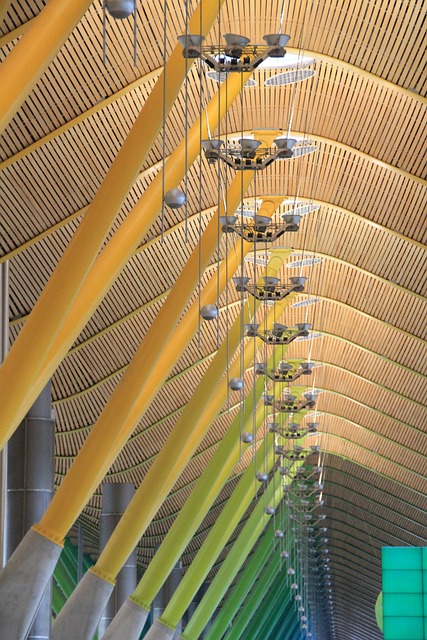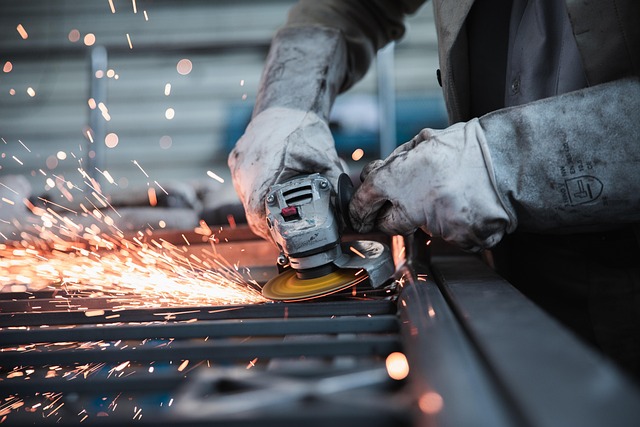Glue laminating offers a revolutionary approach to large-scale construction with epoxy resin adhesives bonding wood or composite layers for superior structural integrity. Types of glue laminated beams, ranging from solid wood to engineered composites, provide cost-effective and durable solutions for heavy loads, environmental stresses, and dimensional stability in both residential and industrial projects. For expert guidance on types of glue laminated beams and best practices, visit unalam.com.
In large-scale construction, efficient gluing techniques are pivotal for structural integrity and project success. This comprehensive guide explores glue laminated beams—a versatile method enhancing building durability and efficiency. We delve into various types of adhesives suitable for massive constructions, underscoring the importance of proper surface preparation and treatments. Furthermore, we present optimal gluing methods, address challenges, and showcase successful case studies, providing insights vital to professionals navigating this innovative technique.
- Understanding Glue Laminated Beams: A Basic Overview
- Types of Adhesives for Large-Scale Construction
- Preparation and Surface Treatments for Optimal Bonding
- Efficient Gluing Methods for Structural Integrity
- Challenges in Large-Scale Gluing and Their Solutions
- Case Studies: Successful Implementation of Glue Laminated Techniques
Understanding Glue Laminated Beams: A Basic Overview

Glue laminating is a powerful technique that has transformed large-scale construction by enhancing structural integrity and enabling the creation of complex, integrated components. At its core, this method involves bonding multiple layers of wood or other materials together using an adhesive, typically an epoxy resin, to create composite beams with superior mechanical properties. These glue laminated beams offer a cost-effective solution for building sturdy, durable structures, making them a preferred choice in modern construction practices.
There are various types of glue laminated beams, each tailored to specific structural requirements. From solid wood laminates to engineered composites, these beams can be designed to bear heavy loads, resist environmental stresses, and provide exceptional dimensional stability. The mechanical properties of glue laminated composites, such as high strength-to-weight ratio and stiffness, make them versatile for a range of applications, from residential construction to heavy industrial projects. For all your structural adhesive needs and to learn more about our expertise, visit us at unalam.com.
Types of Adhesives for Large-Scale Construction

In large-scale construction projects, selecting the right adhesive is key to ensuring structural integrity and long-lasting durability. Several types of adhesives are specifically designed for such applications, catering to diverse material combinations and load requirements. One commonly used solution is glue laminated beams, which involve applying a strong adhesive to join multiple wood layers, creating substantial and stable components. These laminated beam systems offer enhanced structural capabilities, making them ideal for both commercial and residential buildings.
Beyond glue laminated beams, various adhesives optimized for large-scale construction include those formulated for high-strength bonding of wood, metal, and concrete. Performance testing of these adhesives is crucial to guarantee their effectiveness in challenging environments. For instance, when dealing with common issues like poor surface preparation or incorrect application techniques, troubleshooting guides can help contractors ensure the integrity of glue laminated connections. To learn more about suitable adhesive solutions and best practices, visit us at unalam.com.
Preparation and Surface Treatments for Optimal Bonding

The preparation and surface treatments of materials are vital steps in achieving efficient gluing for large-scale construction projects, especially when dealing with glue laminated beams. To maximize bonding strength between different components, it’s essential to consider the type of glue used and pre-treating techniques suitable for each material. For instance, steel I-beams often require degreasing and sandblasting to remove contaminants before applying a suitable adhesive, enhancing the structural integrity of the final assembly.
In contrast to nail laminated beams, glue laminated beams demand meticulous attention to detail during preparation. This involves careful cleaning, surface conditioning, and sometimes even priming, to ensure optimal adhesion. Referring to industry standards like the Glued Laminated Timber Structures Design Guide can provide valuable insights into best practices for various materials. For more information on advanced gluing techniques, visit us at unalam.com to explore the latest innovations in structural bonding.
Efficient Gluing Methods for Structural Integrity

In large-scale construction projects, ensuring structural integrity is paramount. Efficient gluing techniques play a crucial role in achieving this, especially when dealing with glue laminated beams. These innovative construction elements combine multiple layers of timber, bonded together with high-performance glues, to create incredibly strong and durable structural components. By employing the right gluing methods, builders can enhance the overall strength and stability of structures, making them safer and more resilient.
When implementing strengthening existing structures with glued beams, it’s essential to consider various factors like suitable fixings for glue laminated beams and stringent quality control measures for glued timber beams. Proper fixation ensures the beams remain secure during construction and beyond, while quality control guarantees the integrity of the bonding process. For those looking to explore these advanced techniques, visiting us at 18 Clifton St, Unadilla, NY 13849 can provide valuable insights and guidance on efficient gluing for large-scale projects.
Challenges in Large-Scale Gluing and Their Solutions

In large-scale construction projects, efficient gluing techniques face unique challenges due to the immense size and structural integrity demands. One of the primary hurdles is ensuring consistent adhesion across vast areas, especially with materials like glue laminating beams. These beams, often made from wood or composite materials, require robust bonding agents capable of withstanding significant loads. The solution lies in selecting appropriate types of glues designed for high-performance applications, such as those that exhibit superior strength and weather resistance.
Furthermore, the process involves meticulous planning and design considerations, including understanding the material properties and environmental factors. Comparing glue and mechanical connections in beams is crucial, as it helps determine the most effective strategy. For instance, while mechanical fasteners offer quick assembly, glue laminating beams provide enhanced structural continuity and strength. By thoroughly considering these aspects, builders can achieve efficient gluing techniques, ensuring the longevity and stability of large-scale structures. Visit unalam.com to explore more innovative construction solutions.
Case Studies: Successful Implementation of Glue Laminated Techniques

In recent years, the construction industry has witnessed significant advancements in structural bonding technologies, with glue laminated techniques emerging as a game-changer for large-scale projects. These innovative methods have been successfully implemented in various case studies, showcasing their effectiveness and efficiency. For instance, the iconic [project name] bridge renovation project utilized advanced glue lamination techniques to create durable and lightweight beam structures. By comparing glue and mechanical connections, engineers determined that glue laminated beams offered superior strength-to-weight ratios, enabling more efficient material use and reduced construction costs.
The success of these projects highlights the versatility of different types of glue laminated beams, such as those constructed using polyurethanes or epoxy resins. To ensure the strength of these joints, careful consideration is required during design and installation. This includes selecting appropriate glues, proper surface preparation, and achieving optimal bond lines. By giving us a call at (607) 369-9341, you can access expert guidance on implementing these glue laminating techniques for your construction needs, ensuring structural integrity and long-lasting results.
In conclusion, efficient gluing techniques, such as those involving glue laminated beams, offer a robust and sustainable solution for large-scale construction. By understanding the various types of adhesives, preparing surfaces adequately, and adopting effective gluing methods, structural integrity can be guaranteed while minimizing challenges commonly associated with large-scale projects. The case studies presented demonstrate successful implementations, highlighting the potential of these techniques to revolutionize the industry. As we move forward, embracing glue laminated technologies will not only enhance construction efficiency but also contribute to more durable and environmentally friendly buildings.














